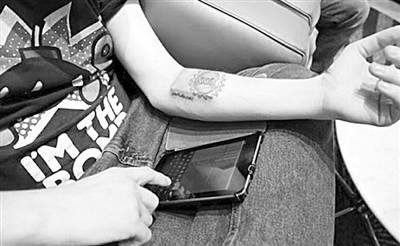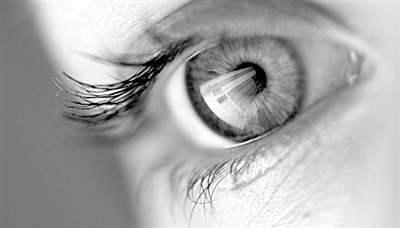According to the US CNN website, when people are still talking about wearable smart devices, it will be the next blue ocean. The city has changed its flag, and implantable devices have been surging. We have developed electronic tattoos, password tablets and memory chips. These devices not only better monitor our health, but also enhance our sensory capabilities in other areas. They have become the new darling of technology. However, some scientists also said that the lack of public awareness is the biggest "roadblock" encountered by this technology in the development process.
"Left-handed" compass: let you not get lost
When we explore in remote forests, we can use smartphones to guide ourselves unless we lose the signal; but now, with the rise of a new round of implantable devices, we can also use one embedded in the body. The guiding system is unimpeded in the forest, and you don't have to worry about getting lost while enjoying the fun of outdoor adventure.
Electronic engineer and molecular biology hacker Brian McCoy designed the first implantable compass, and he himself was the first to eat crabs. The compass, called "Southpaw," works by enclosing a miniature compass in a silicon sleeve, then a round titanium casing, and then implanting it under the skin. There is an ultra-thin whisker that is exposed to the outside. When the user faces north, this thin whisker is activated, slightly irritating the skin.

The subcutaneous implant device Circadia 1.0 collects basic biometric data such as the implant's body temperature and enables real-time data transmission via Bluetooth.
McCoy said: "Because it's disc-shaped, it's best to put it near the shoulder. I haven't thought of any possible safety issues because the materials and shapes used in this device can be tolerated by the body. In scope, McCoy is working with relevant experts to minimize the risk and then implant it into his body.
Although only McCoy will accept this kind of implant, McCoy has never been alone in fighting. "Southpaw" has always been a multi-person research and development project, and its research and development through the field of "leaders" Conducted by the Biohack.me forum, which attracts scientists from many fields around the world, and the technology has surpassed wearable technology to achieve implantable technology. In fact, people who have personally implanted before, such as tech madmen who have magnetic headphones in their ears, artists who have radio frequency identification (RFID) chips on their hands to store photos, etc., are these people. With its own body, it has greatly promoted the development of implantable technology.
Magnets and microchips are almost a must-have component for all implanted devices, sometimes for good looks, sometimes for some novelty. However, with the continuous development of technology, implanted devices have become more and more complex, which can provide people with many practical applications. For example, Circadia 1.0, a subcutaneous implant device developed by the Bio-Hacker Forum, is a good example. The company's CEO, Tim Cannon, even implanted it directly under the skin of his arm. Today, the Circadia model can only collect basic biometric data such as the implant's body temperature, but can perform real-time data transmission via Bluetooth. The device also has 3 LED lights, which not only act as a status indicator, but also illuminate his tattoo from the skin, very trendy.
Built-in headphones: let you "listen" to the temperature
Another star of the forum, Richie Lee, is a pioneer in the use of magnets. Li’s “invisible earphones†implanted in his ear not only allowed him to throw away the headphones, but also allowed him to listen farther (at least farther than normal) and successfully transformed into “Batmanâ€.
Lee implanted a tiny magnet in his tragus - a small protrusion in front of the ear canal, and wore a coil around his neck. After the audio signal was transmitted to the magnetic field, it would cause the magnet implant to vibrate. And produce sound.

Retinal implant devices capable of restoring the vision of blind patients have been available.
In addition, Li also intends to connect his micro wireless system with ultrasonic range finder, thermometer, etc., so that he has the ability to "listen" to the distance like a bat, and feel the amount of something without touching it. heat. Li said: "This is the sixth sense. In addition, I can also detect the magnetic field and WiFi signal, this device has greatly expanded my perception."
Lee's equipment not only makes him cool, but also has practical use, because his vision is deteriorating, he hopes to improve his sense of direction through a better sense of sense. However, Li sees this “self-implantation†as a journey of exploration and discovery rather than a medical attempt.
Another attempt by Lee is to implant the device into the nose, hoping to control the temperature of the body, thereby increasing the user's physical strength and endurance.
Lee is convinced that the ever-improving implants as technology advances will make our bodies healthier and happier, and for this reason, he is willing to undergo any implant surgery. Li said: "If every 18 months have a better product, I will buy it. I think that people will be used to using mobile devices in the future."
Moreover, such devices will be more and more. The writer and bio hacker Frank Swing's hearing is also deteriorating, and he hopes to develop a new implant device that will improve his hearing. This device converts environmental data (such as WiFi signals) into sound, allowing users to navigate themselves. Currently, he has received commercial funding and the equipment model will be available this fall.
The equipment implanted inside the ear has also changed our lives. In June last year, the 3-year-old boy, Grayson Clemp, received the first child-assisted hearing chip implanted in the brain stem with the help of the University of North Carolina School of Medicine, and heard the sound for the first time.
Moreover, retinal implant devices capable of restoring the vision of blind patients have been available, and developers hope that such implants will not only restore the vision of blind patients, but also improve and improve the vision of non-blind patients.
RFID chip: let you say "goodbye" with your password
In addition, subcutaneous radio frequency identification (RFID) chips have been around for a while, and the developers have made them into "small capsules" and successfully penetrated into the user's body. This small capsule is 12 mm long and 2 mm in diameter and is made of SCHOTT 8625 glass with good biocompatibility, which is basically not bio-repulsive to the human body.
The capsule has a built-in communication chip, which can closely combine NFC and RFID, and can use the short-range communication standard on the mobile phone to unlock and transfer business cards. At the same time, It also supports the radio frequency identification data transmission of the ISO14443A protocol, which can be used for brushing the door and starting the car. Researchers say the device is expected to replace the passwords for smartphones and tablets.

A subcutaneous radio frequency identification (RFID) chip in the form of a "small capsule."

Motorola is also currently developing tablets with RFID chips.
Known as the "RFID Boy", Amar Grafestella was the first "crab-eater" to try to implant a radio frequency identification chip. As early as 2005, he injected similar capsules into the body. He said: "Recent breakthroughs have given these chips more storage and other potential. There are about 880 bytes of storage, 97 times the previous one, so you can only store one name and one phone before. Number, but now you can store more content."
Motorola is currently developing tablets with the same features, and users can swallow this medicine, which saves you the trouble of remembering your password.
"Electronic Tattoo": Makes you healthier
Electronic tattoos incorporating microcircuits are expected to become future health care surveillance devices. One of the leaders is the BioStamp, a material scientist at the University of Illinois at Urbana-Champaign, John Rogers. The device consists of ultra-thin electrodes, electronic components, sensors, wireless power supplies and communication systems that can now measure the wearer's heart rate, skin temperature, tension and hydration levels, all of which help professionals track The wearer's health indicators, for example, can monitor the healing of the wound; in addition, the doctor or nurse can wirelessly transmit the measurement information back to the hospital by simply attaching the electronic tattoo to the surgical wound before the patient leaves the hospital.

Electronic tattoos consist of ultra-thin electrodes, electronic components, sensors, wireless power supplies, and communication systems that measure key data such as the wearer's heart rate, blood pressure, and skin temperature.
Rogers is not only a university professor, but also the co-founder of MC10, a pioneer in the field of bioelectronics. MC10 hopes that its "electronic tattoo" can not only expand the human ability in an invisible way, but also serve us. Health protection, monitoring key data such as heart rate and blood pressure at any time, and transmitting it to doctors or binding to smartphones in real time. The company's next goal is to improve the "bio-stamps" to enable it to integrate wireless communication systems, which will allow micro-sensors to further connect with existing smart devices, triggering a new round of industry innovation.
Coincidentally, Motorola also released a temporary electronic throat tattoo last year that communicates with devices such as smartphones, tablets and Google Glass. Researchers at the University of Southern California hope to test a device that can restore the memory of patients with brain damage in the next two years. The ultimate goal of the device is to cure Alzheimer's disease.
Questioning voices come and go
Although the implanted device "looks beautiful", it seems to be highly sought after by geeks, but it has also encountered the biggest "blocker" in its development - public perception.
In many countries in the United States and Europe, hospitals are forbidden to implant similar devices; moreover, there is a general lack of trust in biological hackers. Anthony Giuseppe-Avery, an editor at Bioengineering and a professor of bioengineering at the University of Southern California, stresses that the basics of medicine are solving problems rather than making healthy people stronger.
However, Giuseppe Avery also acknowledges that these bio-hackers are also driven by the public's acceptance of emerging technologies such as cochlear implants and retinal implants that have achieved great success in improving the condition of patients with hearing and visual impairment. By.
Giuseppe Aily said: "Public cognition is the main barrier. They believe that implanted devices can make people feel uncomfortable. But we have also seen that they may have a huge impact, RF implant devices also It has proven to have great potential in the treatment of Alzheimer's disease, and its use does not stop there."
In order to minimize the invasiveness of such equipment, Giuseppe Aily suggested that people should consider two aspects when developing such equipment. "These equipment must be small and easy to supply, so that it is not necessary. A lot of repetitive operations. In the second aspect, induction coils and biofuel cells using body energy are slowly becoming a solution."
The research team led by Giuseppe Avery is currently working on an "electronic tattoo" equipped with sensors, "intimate contact" with the skin, no invasive surgery, no critical signals, and the ability to transmit signals over wireless data. This kind of tattoo has attracted countless scientists to compete.
Giuseppe Avery said that the tattoo is also widely used and can be used to read brain waves from the head. Although devices implanted in the brain can tell us more, there is a huge risk of implanting the device into the brain. If the body rejects the raw materials of the manufacturing equipment, it may cause the patient to die.
However, the British Wellcome Foundation is currently experimenting with Alzheimer's disease patients who have implanted a silicon chip inside their brains that monitors brain conditions and predicts possible dangerous conditions for patients. It can also stimulate debilitating nerve cells. A similar experiment was being conducted by the US Department of Defense's Advanced Research Projects Agency, which implanted chips into soldiers to better control the trauma of soldiers. Although these experiments pose great challenges to the basic principles of medicine, the researchers believe that the chip will ultimately enhance the soldier's performance in war by improving the soldier's consciousness, memory and mood.
Poe Umbrella,Pvc Umbrella,Window Umbrella,Strong Pole Umbrella
SHAOXING TIANYU UMBRELLA INDUSTRY CO.LTD , https://www.tianyuumbrella.com